| Lesson Subject:
Understanding Chords |
| What you learn:
Basic Chord Formulas |
| Teacher: Michael Johnson |
Lesson Intro
Michael:
Welcome class, this lesson series covers chord
theory and understanding the basic concepts of building
chords. With this information you'll be able to figure out how to build chords
on your own. There is so much you can do with the
fretboard. I will try to help you unlock this mystery. Here's the basic stage of a
scale breakdown of a triad, arpeggio and chord and the various positions you can
play on the neck.
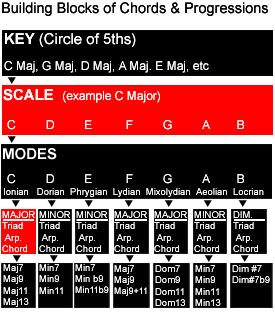
Michael:
We will start with the key of C MAJOR: C, D, E,
F, G, A, B, here's the first
pattern.
Michael: This gives you a very basic pattern.
The neck has many positions where you can play "C" (as it is with other scales
as well). Load the next guitar link,
play and you will see all the positions be displayed on the virtual neck, EVERY C note will be highlighted:
C Root Note Positions (click guitar neck link)
Michael: See all the positions of "C".
This will
help you visualize what is happening on the neck. When I play the guitar
I visualize PATTERNS and root notes, this helps me jump from chord to chord and
scale to scale quickly, this is important. OK, now the C MAJOR scale is positioned
all over the ENTIRE NECK. Here's all the notes you can use, EVERY note in C Major:
C, D, E, F, G, A, B will be highlighted.
C Major Scale Positions (click guitar neck link)
Michael:
See all the positions you can play on the virtual neck. The "circle of 5ths" are
the next stage for understanding KEYS. The next few tabs will help illustrate where you
can play various C Major chords and
arpeggios. Can anybody tell me what an "arpeggio"
is?
Rhinosaur: Notes of the chord or scale played in a
row?
lebaron: The notes of a chord played individually in succession?
Michael:
Those are good answers, an arpeggio is a
sequence of specific notes (4 or more) used within the scale pattern. Here's a
breakdown of some basic music theory concepts and terms:
SCALE THEORY:
C MAJOR SCALE:
C (I), D (II), E (III), F (IV), G (V), A
(VI), B (VII), C (octave)...
The I, III, V notes used in Major chords, arpeggios and triads (highlighted in red):
C MAJOR SCALE:
C (I), D (II), E
(III), F (IV), G
(V), A (VI), B (VII), C
(octave)...
TERMS:
1. Triad: picking 3 notes only of the scale:
example: C, E, G
2. Arpeggio: picking 4 or more notes of the scale individually
in sequence
<ascending and/or descending>:
example: 4 note C Maj arpeggio C, E, G, C
example: 5 note C Maj arpeggio C, E, G, C, G
example: 6 note C Maj arpeggio C, E, G, C, E, G
3. Chord: strumming/picking 3 or more notes of the scale
<note: these notes do not need to be in any specific order>
example: 3 note chord C, E, G
example: 4 note chord C, G, C, E
example: 5 note chord C, E, G, C, E
Michael: The next tab will visually illustrate
these concepts:
Michael: First let's break down the C MAJOR scale
into 4 positions and you'll see how we get the arpeggios for each of
these.
Michael:
Do you see how you can play various positions of the C MAJOR
scale.
Dana:
wow
james:
amazing
Michael: Does this confuse anybody so
far? This allows you to play scales,
arpeggios and chords in various positions. This is the secret of the
fretboard, it's knowing how to find these positions
and the fretboard won't be such a mystery to you.
Dana:
I
never knew that I could do that so easy.
Michael:
It's simple math. OK, now we have have the C major scale
in various positions. It's all patterns and note sequences, we'll get into this
later in the lesson. Now you know how to pick out the
arpeggio notes out of the scale, C (I), E (III), G,
(V).
Dana: Is
it always 1 3 5 ?
Michael: Dana for major yes, we'll learn to
expand later. Now here's how you get the arpeggios and
cord positions as well, for now we'll use the basic 1, 3, 5
major. Here's the breakdown for the C major chord, arpeggio and triad. All of
these are related, here's a breakdown of the terms and the scale. Now here are various positions of C major scales and arpeggios.
Michael:
These positions give you the chord
positions as well. Now let's take all the positions we can
play various positions of the C Major
chord. EVERY note you can use in a C Major chord, triad & arpeggio will be
highlighted:
C (I), E (III), G (V):
C Major Chord Positions (click guitar neck link)
lebaron: That's
intimidating lookin', tab every chord needs a i, iii,
v?
Michael:
Don't worry lebaron, I'll break it down for you. We will use this chart for
reference and break it down into sections of chords. OK, now for the fun stuff, let's take
these notes and break them down into chord positions. First let's use the C on
the 3rd fret/5th string (A).
lebaron: This is weird, you can see the shapes, like a d
shape, e shape, a shape is that what you mean by
visualizing?
Michael: You sure can lebaron, that's is
the whole idea of the lesson.
C Major - 1

Michael: OK, let's take another position using the
same root note on the 3rd fret/5th
string.
C Major - 2
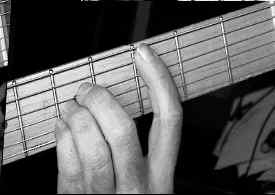
Michael: OK, the last chord can commonly be
played like a barre chord on the 3rd fret/5th string, just omit the note on the little
E.
C Major - Barre 2
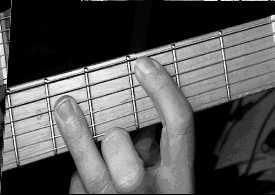
Michael: In this example we have C, G, C, E.
james: You can
play C chord either way?
Michael:
Yes James, in many ways. That's the point of this lesson, you
just shuffle the C, E, & G around. In the other one you use C, G, C, E,
G. Here's an example:
Michael: Do you see the notes
used?
Glenn: yes
Michael: Now you can add notes over the C that are relative to the scale. In this example I'll play the common open C Major and add the G to the 6th string.
C Major - w/G Bass Note
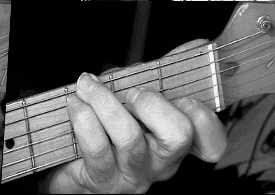
Dana: OK I understand
Michael: OK, let's look at other
positions.
C Major - w/G

Michael: This is a common C major barre chord.
Michael:
See how they share all the same notes. Here's another position.
C Major - Root on 6th String
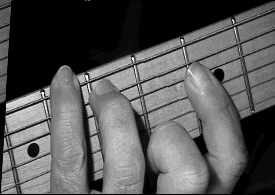
lebaron: It makes me realize I need to know the names of the notes all over the fret
board, I guess.
Michael:
If you take a look at the reference tab I gave you earlier you can come up with all kinds of variations on your
own. Two things lebaron; knowing how to find
a root note is one key, and knowing how to play the scale pattern is the second
key point.
lebaron:
To
be able to figure this out in other keys.
Michael:
Here's two last chords.
C Major - Root on 5th String
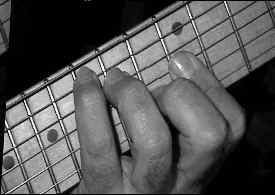
Michael: The chords come from the scales, here's all the chords
together.
lebaron:
C
shape above the barre, right? You are doing great, thanks for all your help!
Michael:
Yes lebaron, now you can play sections of each of these chords to give an
"ascending" type sound, but using all the same chords. This technique is used in
jazz and classical.
Michael: Now you can pick portions of each of these chords to give an
"ascending" type sound, but using all the same chords. This technique is used in
jazz and classical.
Michael: We'll thanks everybody, I look forward
to seeing you at the next lesson on Understanding Chords,
bye!
|
<< load notation from left
|